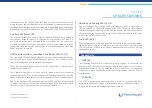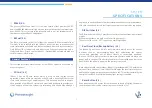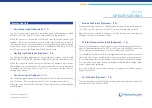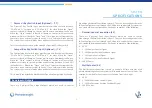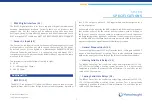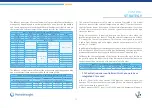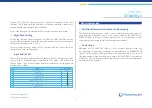
www.monodraught.com
info@monodraught.com
5
SYSTEM
SPECIFICATIONS
USB (5.1)
JTAG (5.2)
Auxiliary 24V Power LED
Heating and Cooling LEDs (4.3.4)
Fault LED (4.3.5)
USB Communications, Heartbeat, and Power LEDs (4.3.3)
The external temperature sensor, rain/heat connector, RS485 4-way terminal
and general purpose inputs are supplied by the auxiliary 24V which is
protected from the main 24V supply by a resettable fuse. Any shorts or
overloads on these connections will trip the fuse, removing power from these
connections and causing LED3 (located between the buttons and the 4-way
RS485 terminal) to turn off.
The 4 x Heating and 4 x Cooling solid state relays are silent in operation, so
LED 8-9 and LED 11-16 show the status of the SSRs. The green LEDs indicate
that the corresponding cooling relay is active and the red LEDs indicate that
the corresponding heating relay is active. Each LED is positioned to the right
of the terminal it corresponds to.
The Fault output is a solid state relay and has an LED to indicate its operation.
When the panel is off or a fault has occurred, the relay de-energises and
LED 18 turns off. If LED 18 is on, then it indicates that the system is OK and
operating normally.
The USB type B socket (J7) on iNVent 2 allows an engineer to connect to the
panel in order to see the status and configuration of the panel via the iNVent
Configurator software. This enables the iNVent 2 panel to be reconfigured
to operate in more advanced and custom configurations than the default
configuration.
The JTAG programming connector (K1) is used for programming new
firmware to the panel using an ST Microelectronics STLinkV2 programmer. It
is also used for internal development of new firmware.
The cluster of 4 LEDs below the USB port are used to indicate communications
over the USB port, as well as indicating the presence of 3.3V power to the
control circuitry and operational status of the panel.
LED 2 indicates data transmission to the PC, whilst LED 4 indicates data
transmission from the PC.
LED 6 indicates that there is 3.3V on the PCB, which means that the control
circuitry is powered. If 24V has been connected to the panel but the power LED
does not illuminate, then there is a fault in the panel’s 24V to 3.3V power supply.
LED 7 is the heartbeat LED and the purpose of the LED is to flash intermittently
to indicate that the system is active and operational. If this light fails to flash,
then there is an issue with the control circuitry or firmware.
illuminated, then the 24V power for that zone is active. If too much current is
drawn through a short circuit or because of overloading by too many devices, the
resettable fuse will trip until the load is reduced to acceptable levels and the LED
will turn off. These LEDs are marked on the PCB as LED1, LED5, LED10 and LED17.
Connectivity





